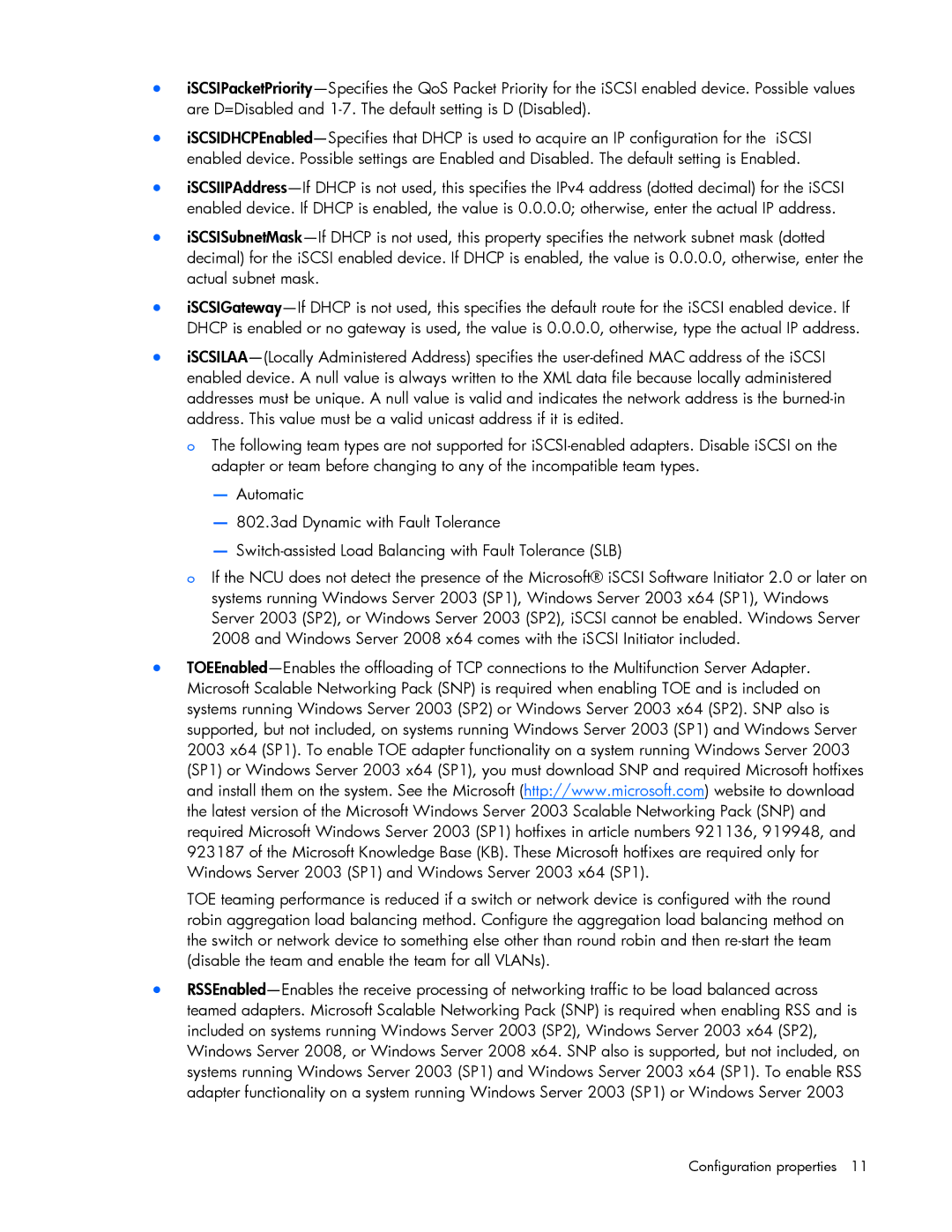•iSCSIPacketPriority—Specifies the QoS Packet Priority for the iSCSI enabled device. Possible values are D=Disabled and 1-7. The default setting is D (Disabled).
•iSCSIDHCPEnabled—Specifies that DHCP is used to acquire an IP configuration for the iSCSI enabled device. Possible settings are Enabled and Disabled. The default setting is Enabled.
•iSCSIIPAddress—If DHCP is not used, this specifies the IPv4 address (dotted decimal) for the iSCSI enabled device. If DHCP is enabled, the value is 0.0.0.0; otherwise, enter the actual IP address.
•iSCSISubnetMask—If DHCP is not used, this property specifies the network subnet mask (dotted decimal) for the iSCSI enabled device. If DHCP is enabled, the value is 0.0.0.0, otherwise, enter the actual subnet mask.
•iSCSIGateway—If DHCP is not used, this specifies the default route for the iSCSI enabled device. If DHCP is enabled or no gateway is used, the value is 0.0.0.0, otherwise, type the actual IP address.
•iSCSILAA—(Locally Administered Address) specifies the user-defined MAC address of the iSCSI enabled device. A null value is always written to the XML data file because locally administered addresses must be unique. A null value is valid and indicates the network address is the burned-in address. This value must be a valid unicast address if it is edited.
o The following team types are not supported for iSCSI-enabled adapters. Disable iSCSI on the adapter or team before changing to any of the incompatible team types.
—Automatic
—802.3ad Dynamic with Fault Tolerance
—Switch-assisted Load Balancing with Fault Tolerance (SLB)
oIf the NCU does not detect the presence of the Microsoft® iSCSI Software Initiator 2.0 or later on systems running Windows Server 2003 (SP1), Windows Server 2003 x64 (SP1), Windows Server 2003 (SP2), or Windows Server 2003 (SP2), iSCSI cannot be enabled. Windows Server 2008 and Windows Server 2008 x64 comes with the iSCSI Initiator included.
•TOEEnabled—Enables the offloading of TCP connections to the Multifunction Server Adapter. Microsoft Scalable Networking Pack (SNP) is required when enabling TOE and is included on systems running Windows Server 2003 (SP2) or Windows Server 2003 x64 (SP2). SNP also is supported, but not included, on systems running Windows Server 2003 (SP1) and Windows Server 2003 x64 (SP1). To enable TOE adapter functionality on a system running Windows Server 2003 (SP1) or Windows Server 2003 x64 (SP1), you must download SNP and required Microsoft hotfixes and install them on the system. See the Microsoft (http://www.microsoft.com) website to download the latest version of the Microsoft Windows Server 2003 Scalable Networking Pack (SNP) and required Microsoft Windows Server 2003 (SP1) hotfixes in article numbers 921136, 919948, and 923187 of the Microsoft Knowledge Base (KB). These Microsoft hotfixes are required only for Windows Server 2003 (SP1) and Windows Server 2003 x64 (SP1).
TOE teaming performance is reduced if a switch or network device is configured with the round robin aggregation load balancing method. Configure the aggregation load balancing method on the switch or network device to something else other than round robin and then re-start the team (disable the team and enable the team for all VLANs).
•RSSEnabled—Enables the receive processing of networking traffic to be load balanced across teamed adapters. Microsoft Scalable Networking Pack (SNP) is required when enabling RSS and is included on systems running Windows Server 2003 (SP2), Windows Server 2003 x64 (SP2), Windows Server 2008, or Windows Server 2008 x64. SNP also is supported, but not included, on systems running Windows Server 2003 (SP1) and Windows Server 2003 x64 (SP1). To enable RSS adapter functionality on a system running Windows Server 2003 (SP1) or Windows Server 2003
Configuration properties 11
